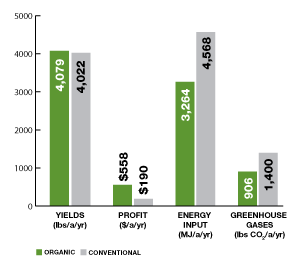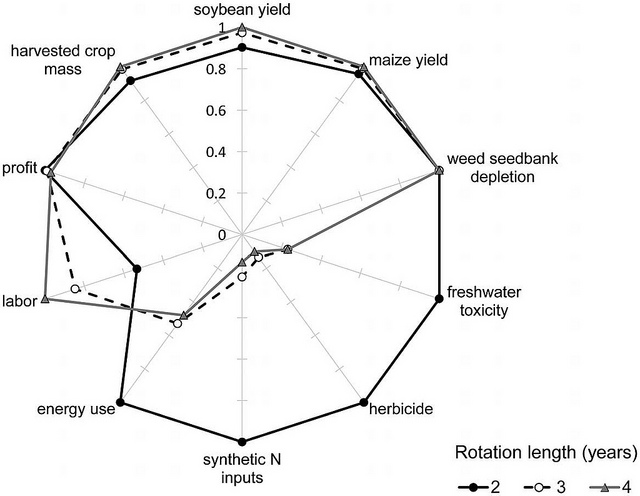Want better yields and the same or more profit? Stop buying pesticides, rotate more crops over longer periods, and mix in animals. Yet another study confirms this. Oh, and a hundred times less disease-causing pesticides in streams, and presumably also less pesticides in the food going to market.
Mark Bittman wrote for NYTimes today, A Simple Fix for Farming,
The study was done on land owned by Iowa State University called the Marsden Farm. On 22 acres of it, beginning in 2003, researchers set up three plots: one replicated the typical Midwestern cycle of planting corn one year and then soybeans the next, along with its routine mix of chemicals. On another, they planted a three-year cycle that included oats; the third plot added a four-year cycle and alfalfa. The longer rotations also integrated the raising of livestock, whose manure was used as fertilizer.
The paper’s Figure 3 (above) illustrates that labor increased with crop rotation length, but so did yield, and profit remained the same or better. How can this be? The figure also shows energy use (fuel) and especially fertilizer and pesticide use plummetted. It’s not clear they even figured in not paying for Monsanto’s overpriced monoculture poison seeds. And without all those herbicides, freshwater toxicity also plummetted.
The results were stunning: The longer rotations produced better yields of both corn and soy, reduced the need for nitrogen
fertilizer and herbicides by up to 88 percent, reduced the amounts of toxins in groundwater 200-fold and didn’t reduce profits by a single cent.
In short, there was only upside — and no downside at all — associated with the longer rotations. There was an increase in labor costs, but remember that profits were stable. So this is a matter of paying people for their knowledge and smart work instead of paying chemical companies for poisons. And it’s a high-stakes game; according to the Environmental Protection Agency, about five billion pounds of pesticidesare used each year in the United States.
An increase in labor costs means more jobs. Smart work instead of poisons! Could be healthier for all of us, starting with the farmers, who are the most directly exposed to the pesticides. And farmers profit the same or more.
The study: Davis AS, Hill JD, Chase CA, Johanns AM, Liebman M (2012) Increasing Cropping System Diversity Balances Productivity, Profitability and Environmental Health. PLoS ONE 7(10): e47149. doi:10.1371/journal.pone.0047149
Why does this sound familiar? Because it’s similar to what Joel Salatin’s Polyface Farm has been doing for years, except he does it without any chemical fertilizer. As explained in the movie Fresh,
…the industrial food system has created two problems out of one solution. By separating animals from plants and creating two monocultures….
 And it’s not like this is the first study that emphasizes crop rotation,
either.
See, for example, the
three-decade Rodale study
that concluded organic four-year crop rotation produced better yields
and more profit than “conventional” pesticided two-year crop rotation.
Here are
some more studies, from Africa and India and elsewhere.
And it’s not like this is the first study that emphasizes crop rotation,
either.
See, for example, the
three-decade Rodale study
that concluded organic four-year crop rotation produced better yields
and more profit than “conventional” pesticided two-year crop rotation.
Here are
some more studies, from Africa and India and elsewhere.
So-called “conventional” agriculture with its cult of petrochemicals to replace labor is hardly more than 50 years old. Maybe it’s time to get back to organic food, or, as our grandparents called it, food.
-jsq
Short Link:
